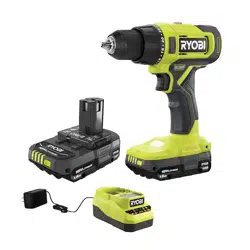Loading ...
Loading ...
Loading ...

7 – English
WARNING:
Battery tools are always in operating condition. Lock the
switch when not in use or carrying at your side, when
installing or removing the battery pack, and when install-
ing or removing bits.
INSTALLING/REMOVING BATTERY PACK
See Figure 2, page 9.
Lock the switch trigger.
Insert the battery pack into the product as shown.
Make sure the latches on each side of the battery pack
snap in place and the battery pack is secured in the
product before beginning operation.
Depress the latches to remove the battery pack.
For complete charging instructions, see the operator’s manu-
als for your battery pack and charger.
INSTALLING/REMOVING BITS
See Figures 3 - 4, page 9.
The arrows on the keyless chuck indicate which direction
to rotate the chuck sleeve to tighten or release the drill bit.
Do not use a wrench to tighten or loosen the chuck jaws.
To install bits, lock the switch trigger.
Open or close the chuck jaws until the opening is slightly
larger than the bit size you intend to use.
Raise the front of the drill slightly and insert the drill bit.
WARNING:
Make sure to insert the drill bit straight into the chuck
jaws. Do not insert the drill bit into the chuck jaws at an
angle, then tighten. This could cause the drill bit to be
thrown from the drill, resulting in possible serious per-
sonal injury or damage to the chuck.
Rotate the chuck sleeve to close and tighten the chuck
jaws.
WARNING:
Do not hold the chuck sleeve with one hand and use the
power of the drill to tighten the chuck jaws on the drill
bit. The chuck sleeve could slip in your hand, or your
hand could slip and come in contact with the rotating
drill bit. This could cause an accident resulting in serious
personal injury.
To remove bits, lock the switch trigger and open the
chuck jaws.
TWO-SPEED GEAR TRAIN
See Figure 5, page 9.
Select low speed (1) for applications requiring higher
power and torque, such as driving screws and drilling in
metal.
Select high speed (2) for fast drilling or driving applica-
tions, for drilling in wood or masonry.
NOTICE:
Never change speeds while the tool is running. Failure
to obey this caution could result in serious damage to
the drill.
NOTE: If you have difficulty changing from one speed range
to the other, turn the chuck by hand until the gears engage.
ADJUSTING TORQUE
See Figure 6, page 9.
Rotate the adjustment ring to the proper torque setting for
the type of material and size of screw you are using.
• 1 - 4 For driving small screws
• 5 - 8 For driving screws into soft material
• 9 - 12 For driving screws into soft and hard
materials
• 13 - 16 For driving screws into hard wood
• 17 - 23 For driving large screws
• For heavy drilling
DRILLING/DRIVING SCREWS
See Figure 7, page 9.
Check the direction of rotation selector for the correct
setting (forward or reverse).
Select low speed (1) or high speed (2), depending on
your application. Refer to Two-Speed Gear Train and
Adjusting Torque.
Secure the workpiece in a vise or with clamps to keep it
from turning as the bit rotates.
Hold the drill firmly and place the bit at the point to be
drilled, or where the screw is to be driven.
WARNING:
Do not drive a screw where there is likely to be hidden
wiring behind the surface. Contact with a “live” wire will
make exposed metal parts of the tool “live” and possibly
shock the operator. If you must drive a screw where hid-
den wire may be present, always hold tool by insulated
gripping surfaces (handle) when performing the operation
to prevent a shock to the operator.
OPERATION
Loading ...
Loading ...
Loading ...
